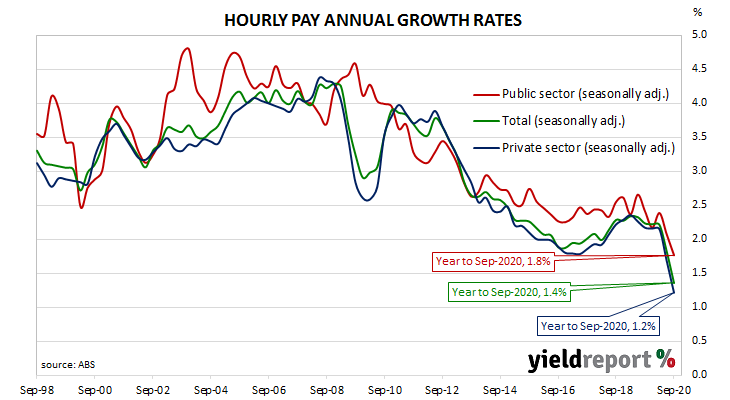Summary: September quarter wage growth slows again; annual growth rate closer to 1% than 2%; public sector support for higher wages “fading”; wages in private sector increase by 1.2% over year, public sector up by 1.8%; ABS underutilisation rate points to continued slowdown.
After unemployment increased and wage growth slowed during the GFC, a resources investment boom prompted a temporary recovery back to nearly 4% per annum. However, from mid-2013 through to the September quarter of 2016, the pace of wage increases slowed, until mid-2017 when it began to slowly creep upwards. After remaining fairly stable at around 2.2% per annum from September 2018 to March 2020, the growth rate slowed significantly in the June quarter.
According to the latest wage price index (WPI) figures published by the Australian Bureau of Statistics (ABS), hourly wages grew by just 0.1% in the September quarter. The increase was less than the 0.2% which had been generally expected and lower than the 0.2% which had been recorded in the June quarter. The year-on-year growth rate slipped from the June quarter’s rate of 1.8% to 1.4%.
“Public sector wages were a significant support for wage inflation this year but this support is fading,” said Westpac senior economist Justin Smirk.

In the cash futures market, expectations of a change in the actual cash rate, currently at 0.05%, eased a touch. At the end of the day, contract prices implied the cash rate would slip a little closer to zero in December and then settle at around 0.04% through 2021.
Hourly wage growth in the public sector has been generally faster than in the private sector since late 2013. There have been just a few quarters over this time period in which the difference has been in favour of the private sector but, again, the September quarter was not one of them. Wages in the private sector grew by 0.1% while wages in the public sector grew by 0.2%. Over the past 12 months, wages in the private sector increased by 1.2% while public sector wages grew by 1.8%. Annual wage growth in the two sectors had been at 1.7% and 2.1% respectively in the June quarter.

